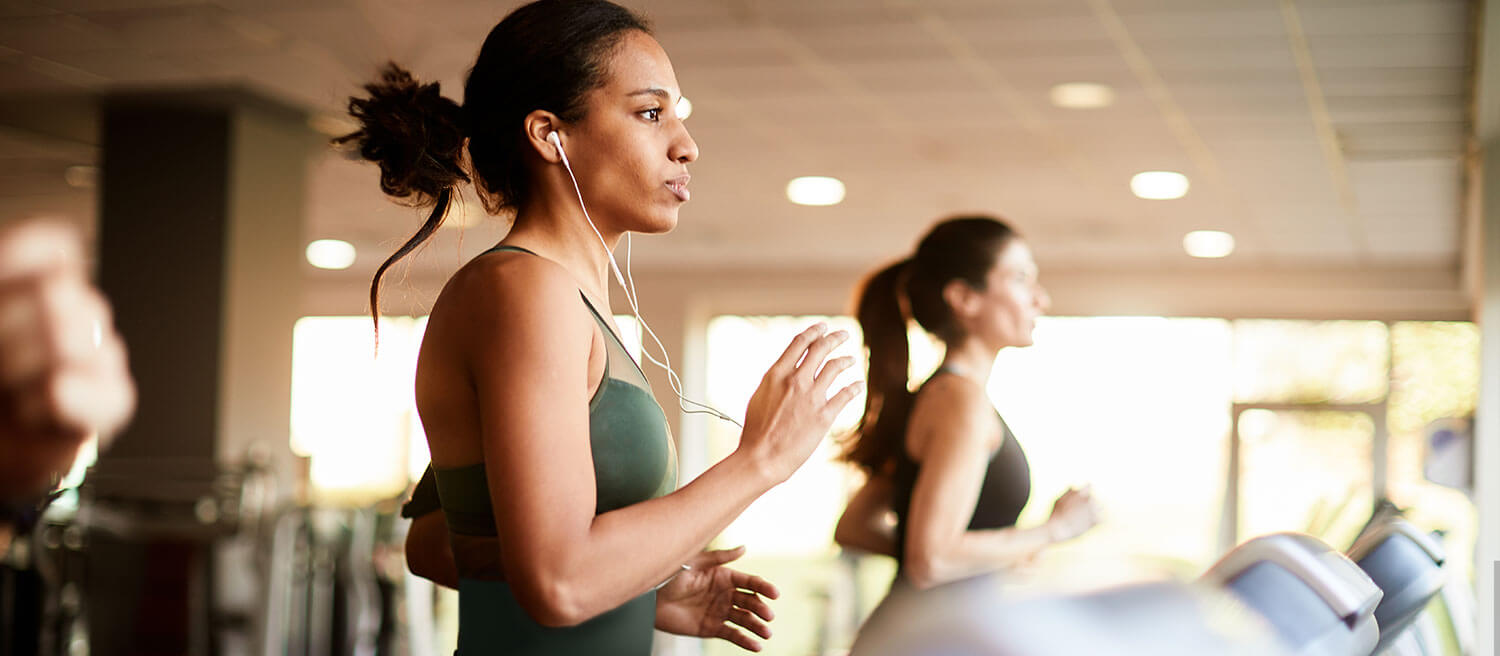
What Is Gymtimidation and 7 Ways to Overcome It
Are you the type of person whose New Year’s resolution is to get more exercise? Except the sound of weights being dropped or others looking in your direction intimidates you?
If you’ve had similar sentiments, you might be suffering from gymtimidation. The below guide will fully explain what “gymtimidation” is and contains expert advice on how to overcome it. We also discuss ways to make your fitness center more inclusive.
Don’t let the fear of going to the gym impede your health and self-care. For a quick summary, view our visual by clicking the button at the bottom of the post.
Gymtimidation Defined

Gymtimidation is the fear and dread of working out in front of other people. This anxiety isn’t just relegated to the gym — it can occur in yoga classes, cycling studios, or any exercise activity where others are present.
According to Thomas Mentus, a personal trainer for six years and an expert panelist at Garage Gym Reviews, people are “way more critical of themselves than others are of them. So, if you can get a handle on your own self-criticism, then the fear of being judged by others will lessen.”
If this experience sounds familiar, you’ve likely experienced gymtimidation before. And you’re not alone.
According to one survey of 2,000 Americans, 47% of all respondents experienced gymtimidation when exercising around others. And 32% felt intimidated when working out near someone whom they perceived to be in “excellent shape.”
So, how does gymtimidation manifest and why do so many people experience it?
Gymtimidation mostly occurs internally. For many people, it derives from their anxieties and nervousness around how they look or feel. These anxious thoughts and emotions are heightened when exercising around others.
We’ll get more into how to overcome gymtimidation later, but for now, know that your fear of going to the gym is valid and shared among many others.
How Different Genders Experience Gymtimidation

Gymtimidation for women and men can resonate in different ways. Please note that these tendencies aren’t binary and overlap does exist. However, these general differences are worth noting.
According to one study, 44% of women at the gym feared using free weights due to not knowing what they’re doing or injuring themselves.
Some of these gym-going women feared judgment from others — with 14% blaming glances or judgment from men for their anxiety and 10% fearing judgment from other women.
The study also found that women, more so than men, were concerned about appearing out of shape and looking clueless around exercise equipment. Only two in 10 men from the study were afraid of appearing clueless while working out.
These emotions fall in line with how many of Dr. Sharon Gam’s clients feel when working out around others. Dr. Gam is a personal trainer with a Ph.D. in Exercise Physiology and over 14 years of experience.
She says that “many of my clients are worried that they’re not doing their exercises correctly. They feel uncoordinated and insecure about the way they move and that they might be judged for doing their exercises wrong.”
Men also experience gymtimidation like women. Many of the feelings occur in both sexes. However, Dr. Gam has noticed some tendencies that men do more often than women:
“Men tend to feel like they aren’t doing enough in the gym when they’re working out around others. They sometimes treat it like a competition and add too much weight to their exercises or try exercises that are too advanced for their current fitness level.”
For both sexes, exercise can correlate with body positivity, but it’s more evident for women. One 2014 study found that in general, women exercise more often than men. The same study found that motivation to exercise differs: “Women reported exercising for weight loss and toning more than men, whereas men reported exercising for enjoyment more than women.”
We can’t say for certain why these differences exist, but they’re worth knowing and acknowledging — especially as you exercise around others.
Ways To Overcome Gymtimidation and Stick With Your Fitness Journey

Conquering your fears about going to the gym is part of your fitness journey. First, you must consistently show up to your fitness center or workout classes. You can’t defeat your fear of gyms without showing up. Below are seven more tips to help you conquer gymtimidation.
1. Grow Your Confidence
For many people, exercising in front of others is a vulnerable act. As stated earlier, many men and women fear being judged by others. Novice gym-goers are often worried that they might look clueless in front of others.
Psychologist and Cognitive Behavioral Therapist Mandy Kloppers believes that these fears of judgment are internal and often exaggerated. “We all want to be liked and we often overestimate the likelihood of others rejecting us.”
This aligns with how many gym-goers feel: They have a heightened sense that others are judging them when in most cases they aren’t. Kloppers suggests overcoming your fears by confronting them head on. “The less you avoid your fears, the more your self-confidence will grow. Do it for yourself and care less about what others think.”
So, the next time you’re working out and have fears or suspect judgment from others, focus on yourself and know that most people at the gym are also concentrating on their own fitness journey.
2. Don’t Stare
How awkward is it when you look up from your treadmill and someone is staring directly at you? Nobody likes a starer, so resist that natural urge and instinct to look at others.
Unfortunately, though, humans are hard-wired to believe that others are staring at them, even if they’re not. This biological sensation is further heightened when it’s ambiguous if someone is actually staring at you.
When people move, especially in your peripheral vision, it’s instinctive to look at them. In a training room, there’s constant movement, which attracts your eyes and often makes you look toward the moving object. Your adrenaline also increases when exercising, which increases pupil dilation. These heightened stimuli can cause people to look at others in the gym more often than they would in other places.
Now that you know that some people — and perhaps you — are self-conscious in the gym, it’s best to remember that your gaze can make others feel uncomfortable. So, when exercising around others, be cognizant of where your eyes drift off to and concentrate on each exercise.
3. Ask for Help
We all need a little help sometimes in life. The gym is no exception. If you’re doing an exercise and need a spotter (someone who can help you safely lift and re-rack the weight) don’t be afraid to ask a nearby person. Most people are willing to help. Plus, it’s a good way to meet other gym members and expand your fitness community.
If you’re unsure how to use an exercise machine or how to do a specific exercise, you can ask a fitness trainer or floor manager for a quick tutorial. You can also schedule a one-on-one session with a personal trainer to learn exercises that correspond with your goals.
4. Find the Gym That Fits Your Needs
According to NPR’s Planet Money, the majority of gyms’ profit stems from members not going. Stacey Vanek Smith, the co-host of Planet Money, states that “people who don’t go [to gyms] are subsidizing the membership of people who do. So, if you don’t work out, you are making gyms affordable for everyone.”
Don’t be one of the people wasting your membership!
To help keep you on top of your fitness journey, choose a gym that fits your needs. Below is a list of questions and concerns to take into account:
- Distance from your workplace or home
- Cleanliness of the gym
- Gym culture: Is it noisy? Do people seem accepting? Are there people similar to your level of expertise?
- During peak times, or when you’ll be going, is exercise equipment open?
- Do their business hours accommodate your lifestyle?
- Are you interested in the fitness classes?
Consider which of these concerns matters most to you and go with that gym. Review these below tips when scoping out a new gym.
- Visit during peak times or when you’ll be working out.
- Carefully review the contract and read the fine print.
- Take a tour to see if there are people similar to your expertise.
- Try a free or week-long membership.
- Choose the gym you feel most comfortable at.
5. Research and Practice at Home
Practicing movements in front of a mirror isn’t just for TikTok stars. If you’re concerned about how you might look in the gym when doing a specific exercise, perform that exercise at home. You can record yourself on a smartphone or practice in front of a mirror.
Dr. Gam recommends practicing “bodyweight variations of the basic exercises (push, pull, squat, hinge, and core)” at home in small repetitions. This will help “build movement skills, which in turn builds confidence.” If you’re still skeptical about your form, do the exercises in front of a mirror.
Like a TikTok star, the internet is also your best friend. There are tons of helpful videos and online blogs explaining different exercises and the best activities for specific muscle groups.
6. Get in the Zone With Your Playlist
You may already be doing this tip at the gym. Ignore others by playing music while exercising. If you’re easily distracted by other people’s conversations or dislike your gym’s noise, consider purchasing noise-canceling headphones.
In fact, listening to music while exercising can be beneficial. According to Scientific American, “Music distracts people from pain and fatigue, elevates mood.” One study also found that those who cycled in time to music required 7% less oxygen than cyclists who did not synchronize their movements to music.
If you’re not sure what to listen to, there are hundreds of curated workout playlists on streaming services. Try out various genres and tunes during your workouts to see which ones pump you up the most.
7. Workout With a Buddy
Working out in a new environment can feel exposing. Find a workout buddy to help support you throughout your fitness journey. Here are a few benefits to working out with another person:
- When you exercise with another person it can feel less intimidating.
- Your partner can help to keep you accountable.
- Your partner is typically a great motivator and knows your limitations.
- You can also spot each other and critique one another’s form.
How To Stop Perpetuating Gymtimidation

Now that you know what gymtimidation is and ways to overcome it, you can also help eradicate gymtimidation within your gym.
According to Melody Sayers, who is the owner of Elevate Your Plate and has a Master of Science in Nutrition, Dietetics, and Food Science, the gym is a unique place and should be thought of as such.
For Sayers, “the gym is actually one of the most unifying places that exists, for everyone is in there for the same exact reasons, regardless of body type, endurance levels, strength abilities, age, gender, sexual orientation, or religion.”
With this viewpoint in mind, here are a few ways to prevent gymtimidation from spreading:
- Stop staring: As noted earlier, staring at others while they exercise can be uncomfortable and intimidating. Focus on your workout and be conscious of where your eyes wander off to.
- Be welcoming: Be friendly to new gym members. Some people want to work out unbothered, but many individuals don’t mind chatting briefly during their workout. At a minimum, try to smile at other patrons. In fact, smiling while exercising can even improve your stamina.
- Offer a spot: If you see someone lifting a weight near their maximum ability, offer to spot for them. Even if they don’t take you up on the offer, most people will appreciate the gesture. Just make sure you’re capable of lifting the weight if something awry were to happen.
- Allow others to work in: During peak hours, you’re likely to want to get in and out of the gym quickly — like most people. If you’re using a specific machine or weight rack for a long time, it’s good gym etiquette to let others work in. If you’re in a rush, let the person waiting know how many sets you have left and notify them when you’re finished.
- Offer advice to others: Giving unsolicited advice can be tricky. However, if you see someone doing an exercise incorrectly or nervously looking around, don’t be afraid to ask them if they want your advice. If they don’t, they’ll say no. In most cases, the person will be grateful for the help. They could even become your next workout buddy.
Now you know what gymtimidation is and how to conquer it. You’re also aware of how to make your fitness space more inclusive and are therefore helping to thwart gymtimidation.
Remember, the most important part of getting past gymtimidation is actually going to your gym or exercise classes. Consistently showing up is the hardest part!
Lastly, if you’re a man in need of wearing comfortable and breathable exercise gear, check out our 360 sports underwear. For women, we have Go Anywhere Pocket Leggings. You can also read our guide on the best underwear for running.


